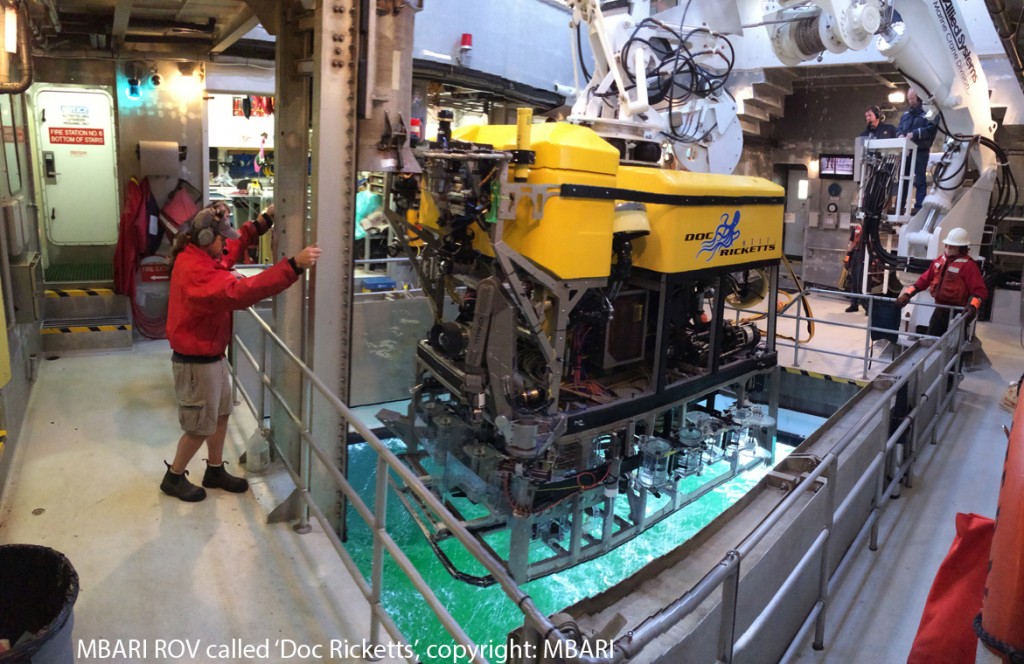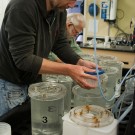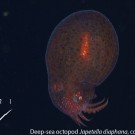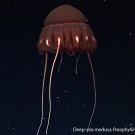Heute meldet sich der Navigators Wochenbericht mit einem spannenden Gastbeitrag. Der Biologe Henk-Jan Hoving, seit fast zwei Jahren Mitglied im Exzellenzcluster “Future Ocean” und Postdoc am GEOMAR, ist zurzeit auf einer Expedition des Monterey Bay Aquariums im Golf von Kalifornien, einer so genannten Sauerstoffminimum-Zone. Sein Spezialgebiet sind die Kopffüßer, wozu beispielsweise auch Tintenfische gehören. Im Rahmen der Forschungsfahrt untersucht er die Organismen in der gesamten Wassersäule vom der Wasseroberfläche bis zum Ozeanboden. Sein Bericht ist Teil eines Expeditionsberichtes des Monterey Bay Aquariums.
Exploring life in the water column from the surface to the deepest parts of the ocean
We are in the Sea of Cortez, Gulf of California, Mexico on a research expedition organized by the midwater ecology lab of Dr. Robison of the Monterey Bay Aquarium Research Institute (MBARI). During this cruise we investigate animals that live in the water column (pelagic animals) from the surface to the deepest parts of the ocean. The overarching research objective of this expedition is to investigate how organisms are impacted by the unique oceanography of this region, which includes an extensive mesopelagic oxygen minimum zone (OMZ) (MBARI Blog day 1).
The research methods we use to collect our data during this cruise are remotely operated vehicles (ROV), state of the art underwater robots that are connected to the ship via cable and controlled by dedicated ROV pilots. These ROVs can reach depths of 1000s of meters and collect high-definition (HD) underwater video of deep-sea animals in their natural habitat. ROVs have shown that jellyfish and other gelatinous fauna are very abundant in the deep sea. The importance of this group of animals was historically underestimated due to the use of nets, which tend to damage these fragile animals. In addition to an HD camera, two kinds of collection tools are present on the ROV. The first is a suction sampler, which can suck up organisms like an underwater vacuum cleaner. The captured specimen is deposited alive in a bucket on the ROV, and stored for the duration of the dive. These buckets are situated in a carousel which holds 12 suction sampler buckets, and a new empty bucket is rotated in position after the capture of a specimen. The second type of collection tool is the detritus sampler, a transparent plastic cylinder which is positioned by the ROV around an animal in the water column. Once the animal is inside the cylinder a lid on top and on the bottom is closed by the action of a hydraulic cylinder and the living deep-sea animal is captured. During this expedition we use two kinds of ROVs; a large 4000 m depth rated ROV called the ‘Doc Ricketts’ and a smaller 1000 m rated mini ROV. During the day we watch the live video feed in the ROV control room while the animals are observed by the ROV. We take shifts operating the camera and using the video annotation system to add identifications to a database which includes all MBARI ROV video observations. In the evenings after 18.30, when ROV operations are complete, we deploy a small trawl net ‘Tucker trawl’ to capture deep-sea animals.
My research program at GEOMAR Helmholtz Centre for Ocean Research Kiel, which is funded through the Cluster of Excellence ‘Future Ocean’, investigates the life cycles, behavior and ecology of oceanic pelagic fauna, and in particular cephalopods. One specific goal of my work is to establish a baseline of pelagic animal diversity, distributions and abundance in relation to the oxygen minimum zone (OMZ) in the Eastern Tropical Atlantic, in particular the Cape Verde area. The OMZ in the Eastern Atlantic has its minimum around 400 meters, with the minimum oxygen concentration that is higher than the Pacific OMZs. However, the oxygen concentration has been changing at a very high rate compared to other regions. The OMZ expansion in the Eastern Tropical Atlantic is responsible for habitat reduction of large active predatory fish such as marlin. However, despite their ecological importance, we do not know what the impact is of OMZ expansion on smaller pelagic organisms such as cephalopods (octopods and squids), mesopelagic fishes and gelatinous organisms such as medusae, ctenophores, doliolids and siphonophores. We know that some pelagic organisms can withstand low oxygen levels for some time e.g. lantern fish migrate into the OMZ during vertical migrations, or some organisms can cope even for longer periods in the OMZ e.g. vampire squid (http://www.mbari.org/news/news_releases/2012/vampfood/vampfood-release.html), ctenophores and owlfish. However, the diversity, abundance and distribution of pelagic organisms associated with OMZs in the Eastern Tropical Atlantic is very poorly known and species-specific distribution patterns need to be obtained. By establishing a baseline of pelagic fauna associated with OMZs, and by monitoring that baseline, we are better able to assess the impact of climate change on pelagic communities, the oceanic food web, the biogeochemical cycle and fisheries.
Since the OMZ of the Gulf of California has such a wide vertical extension (from ~200 m to ~800 m), it may be considered as a future scenario for other smaller OMZs which are subject to expansion and intensification. In our first days of exploring the water column of the Gulf of California we can already see some general patterns for how species are distributed in relation to the wide OMZ. In the upper 200 meters, heteropods, pelagic molluscs, are very abundant, while below 200 meters, their abundance is much reduced. Between 200 and 800 m, in the middle of the OMZ, we see fewer animals in general, a pattern that is typical for OMZs around the world, and which gave them the name ‘dead zones’. Below the lower boundary of the OMZ in the Gulf of California, around 800 m, it seems that certain species occur more frequently. Examples of such species are Chromatonema sp., Paraphyllina sp., cydippid ctenophores and the pelagic octopus Japetella diaphana.
My collaborative work with the Robison midwater ecology lab will eventually allow a comparison of the distribution of pelagic animals between areas with oxygen minimum zones in different ocean basins i.e. the Atlantic and the Pacific.
Henk-Jan Hoving
- Henk-Jan carries sample buckets to the wet table in the wet lab on the Western Flyer. Copyright: MBARI
- The midwater octopus Japetella diaphana is relatively common in the Gulf at depths around 800 meters. Copyright: MBARI
- The large, red jelly Paraphyllina sp. is also a common member of the deep midwater in the Gulf. Copyright: MBARI



